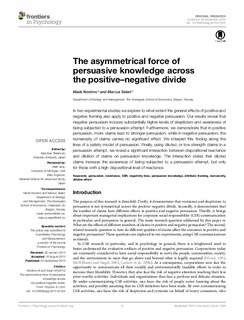| dc.contributor.author | Nordmo, Mads | |
| dc.contributor.author | Selart, Marcus | |
| dc.date.accessioned | 2015-09-14T11:29:47Z | |
| dc.date.accessioned | 2015-09-17T09:10:19Z | |
| dc.date.available | 2015-09-14T11:29:47Z | |
| dc.date.available | 2015-09-17T09:10:19Z | |
| dc.date.issued | 2015 | |
| dc.identifier.citation | Frontiers in Psychology 2015, 6 | nb_NO |
| dc.identifier.issn | 1664-1078 | |
| dc.identifier.uri | http://hdl.handle.net/11250/300459 | |
| dc.description | -Copyright © 2015 Nordmo and Selart. This is an open-access article distributed under the terms of the Creative Commons Attribution License (CC BY). The use, distribution or reproduction in other forums is permitted, provided the original author(s) or licensor are credited and that the original publication in this journal is cited, in accordance with accepted academic practice. No use, distribution or reproduction is permitted which does not comply with these terms. | nb_NO |
| dc.description.abstract | In two experimental studies we explore to what extent the general effects of positive and negative framing also apply to positive and negative persuasion. Our results reveal that negative persuasion induces substantially higher levels of skepticism and awareness of being subjected to a persuasion attempt. Furthermore, we demonstrate that in positive persuasion, more claims lead to stronger persuasion, while in negative persuasion, the numerosity of claims carries no significant effect. We interpret this finding along the lines of a satiety-model of persuasion. Finally, using diluted, or low strength claims in a persuasion attempt, we reveal a significant interaction between dispositional reactance and dilution of claims on persuasion knowledge. The interaction states that diluted claims increase the awareness of being subjected to a persuasion attempt, but only for those with a high dispositional level of reactance. | nb_NO |
| dc.language.iso | eng | nb_NO |
| dc.publisher | Frontiers Media S.A. | nb_NO |
| dc.rights | Navngivelse-Ikkekommersiell-IngenBearbeidelse 3.0 Norge | * |
| dc.rights.uri | http://creativecommons.org/licenses/by-nc-nd/3.0/no/ | * |
| dc.title | The asymmetrical force of persuasive knowledge across the positive–negative divide | nb_NO |
| dc.type | Journal article | nb_NO |
| dc.type | Peer reviewed | nb_NO |
| dc.date.updated | 2015-09-14T11:29:47Z | |
| dc.source.volume | 6 | nb_NO |
| dc.source.journal | Frontiers in Psychology | nb_NO |
| dc.identifier.doi | http://dx.doi.org/10.3389/fpsyg.2015.01324 | |
| dc.identifier.cristin | 1264010 | |

